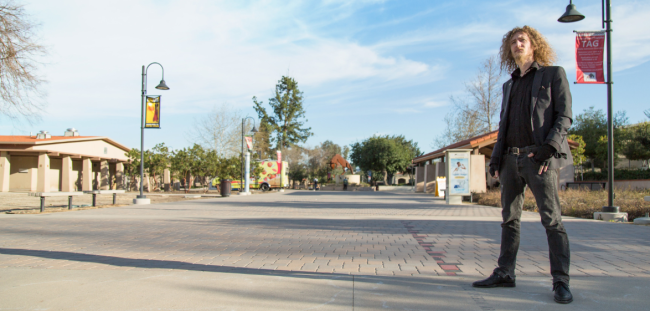You have /5 articles left.
Sign up for a free account or log in.

Kevin Shaw in a free speech zone
Photo courtesy of Dawn Bowery / FIRE.
In 2016, Kevin Shaw, a student at Los Angeles Pierce College, was stopped from passing out Spanish-language copies of the Constitution around the community college. He was told he needed to keep his activities confined to a small slice of campus -- what the institution had deemed its “free-speech zone.”
Such areas, designated at some colleges both public and private, are where administrators expect students to exercise their free-speech rights to avoid interrupting the campus flow. They can be small, such as the one at Pierce College, which was a rectangle no more than three parking spots wide, a little more than 600 square feet -- or limiting in other ways. At the University of South Dakota, a student needs to reserve a free-speech spot at least five days in advance.
These zones are probably going to die.
Experts say that lawmakers are generally quick to banish them from campuses and that they hold up poorly to court challenges. Shaw sued his college -- a lawsuit recently backed by the U.S. Justice Department -- alleging that the restrictions clamped down on all spontaneous speech. In January, a federal district court refused the college's motion to dismiss the case.
In the last year, state legislatures, including those in Colorado, Tennessee and Utah, have stepped in and banned free-speech areas.
Virginia, Missouri and Arizona also previously outlawed the zones. Florida’s Legislature will consider a bill this session that wouldn’t allow them.
Attorney General Jeff Sessions told a crowd at Georgetown University in September that administrators “coddled” students to the point that free expression had been stifled on campuses. The Republican-controlled U.S. House of Representatives introduced a proposal in the reauthorization of the Higher Education Act that would also essentially eliminate the free-speech zones.
“Every public college in America is going to do away with the notion of free-speech zones,” said Frank LoMonte, director of the Brechner Center for Freedom of Information at the University of Florida.
Free-speech zones have generally faltered under legal scrutiny, despite persisting on a number of campuses. The Foundation for Individual Rights in Education (FIRE), the civil liberties watchdog group that has led the charge against free-speech zones on college campuses, located at least 52 institutions with limiting free-speech-zone policies. That's about 11 percent of the roughly 460 colleges and universities it investigates for its “Spotlight on Speech Codes” report.
For years, colleges have faced legal challenges to their free-speech zones and in many cases have done away with them. Grand Valley State University, in Michigan, eliminated its zone last year when students sued.
Back in 2005, members of the College Libertarians at the University of North Carolina at Greensboro broke the student conduct code after they intentionally protested outside the free-speech area to test the university’s policies.
Eventually, the institution dropped the violations against the students and mostly scrapped its free-speech-zone requirements, though overnight protests must still be held in specific places. The university attorney told the Greensboro News & Record at the time that the history of the policy was unknown and may have been a “holdover” from the Vietnam War and civil rights eras.
“I think their days are numbered,” said Joe Cohn, legislative and policy director at FIRE.
The zones were initially developed around the civil rights movement outside of colleges, when the government was struggling how to develop time, place and manner limits on the blossoming protests. This eventually trickled down to campuses, where administrators set up free-speech zones at first as a positive measure, Cohn said. They were meant to be spaces where students were entirely free to protest, but the rest of campus would be open to a degree as well, he said.
In the late 1970s and early ’80s, the interpretation of these policies started to shift to where the zones became the only place students were allowed to protest, which is flatly unconstitutional, Cohn said.
Removal of the zones from college campuses has become a bipartisan rallying point for state legislators, in part because they tend identify with students of different political persuasions who feel their speech has been squashed, Cohn said. Lawmakers also see this as an easy win in working with their colleagues across the aisle.
It’s not much of a heavy lift -- FIRE and the Goldwater Institute have developed model legislation for free expression, which includes striking the zones.
When Missouri’s then governor, a Democrat, signed the bill to outlaw free speech zones in 2015, it was with the overwhelming support of a Republican Legislature, said Tony Rothert, legal director of the American Civil Liberties Union of Missouri, which lobbied for the legislation. Rothert said in a divided government, rarely did legislators come together as they did for this bill. It passed unanimously in the Senate and with a large majority’s support in the House of Representatives.
"I think that everyone agrees in principle that public places where expressive activity can occur is important," Rothert said. "I think that some of the more conservative groups are under the impression -- and I've seen no evidence of this -- but that their voices are not welcome on campus, or they are shut out."
The legislatures are the best arena for solving colleges’ abuse of free-speech areas, because litigation can often be time-consuming and cases don’t differ much, Cohn said. At the University of Cincinnati, for instance, the free-speech zone occupied 0.01 percent of its 137-acre campus, which a federal court in 2012 eventually ruled was so small that it would limit free expression. Cohn posed a hypothetical: if another campus’s free-speech zone was 0.02 percent of the grounds, then a separate lawsuit would be required to challenge it and would likely end with the same result.
Lawsuits over the zones can also be thrown out once students graduate and lose their standing, Cohn said, and lawyers are far more reluctant to take on a case they know will eventually be dismissed. Politicians can close this “loophole,” he said. Some laws, such as in Utah, also allow for students to be compensated for damages -- in some cases $500 for a violation, with $50 for each subsequent breach of the law, along with attorney and court fees paid.
“These are the bodies that can expressly say ‘knock it off,’” Cohn said of state legislatures.
Colleges are allowed to develop “time, place and manner” restrictions, LoMonte said. This means they can ban protests from taking place in areas where they might disrupt the campus.
But designating swaths of lawn where students can have a picnic or play with their dog but might be barred from passing out leaflets doesn’t make sense, LoMonte said.
Some colleges might argue that the zones are necessary from a safety standpoint, LoMonte said -- that allowing students unfettered access to protest wherever they choose could result in large-scale riots on multiple areas of the campus. But the law does not support that reasoning, LoMonte said.
“I think whenever you are taking pieces of property off limits for expression, you are going to be a climbing a very steep hill to justify it constitutionally,” he said.




